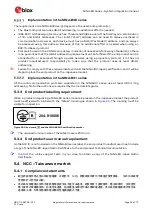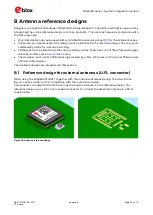
NINA-B3 series - System integration manual
UBX-17056748 - R13
Regulatory information and requirements
Page 53 of 72
C1-Public
Canadian market
User manuals for license-exempt radio apparatus shall contain the following text, or an equivalent
notice that shall be displayed in a conspicuous location, either in the user manual or on the device, or
both:
“This device complies with Part 15 of the FCC Rules. Operation is subject to the following two
conditions:
1.
This device may not cause harmful interference, and
2.
This device must accept any interference received, including interference that may cause
undesired operation.”
Under Industry Canada regulations, this radio transmitter can only operate using an antenna of a type
and maximum (or lesser) gain approved for the transmitter by Industry Canada. To reduce potential
radio interference to other users, the antenna type and its gain should be chosen in such a way that
the equivalent isotropically radiated power (e.i.r.p.) is not more than that is necessary for successful
communication.
Le manuel d’utilisation des appareils radio exempts de licence doit contenir l’énoncé qui suit, ou
l’équivalent, à un endroit bien en vue dans le manuel d’utilisation ou sur l’appareil, ou encore aux deux
endroits.
“Le présent appareil est conforme aux CNR d’Industrie Canad
a applicables aux appareils radio
exempts de licence. L’exploitation est autorisée aux deux conditions suivantes:
1.
l’appareil ne doit pas produire de brouillage;
2.
l’utilisateur
de l’appareil doit accepter tout brouillage radioélectrique subi, même si le brouillage
est susceptible d’en compromettre le fonctionnement.”
Conformément aux réglementations d’Industry Canada, cet émetteur radio ne peut fonctionner qu’à
l’aide d’une ante
nne dont le type et le gain maximal (ou minimal) ont été approuvés pour cet émetteur
par Industry Canada. Pour réduire le 25ecess d’interférences avec d’autres utilisateurs, il faut choisir
le type d’antenne et son gain de telle sorte que la puissance isot
rope rayonnée équivalente (p.i.r.e) ne
soit pas supérieure à celle requise pour obtenir une communication satisfaisante.
5.3
MIC - Japanese market
5.3.1
Compliance statement
The NINA-B3 series modules comply with the Japanese Technical Regulation Conformity
Certification of Specified Radio Equipment (ordinance of MPT N°. 37, 1981), Article 2, Paragraph 1:
•
Item 19 "2.4 GHz band wide band low power data communication system".
5.3.2
48-bit address requirement
Radio devices on the Japanese market, which can be connected directly or indirectly to a public
network, must have an at least 48-bit (12 hex) long ID code. In practice this means that the device
addresses used in the radio communication protocol (Bluetooth, Thread, ZigBee, Gazell etc.) must be
at least 48 bits.
☞
Note that this requirement is not applicable to devices only intended for use in private or personal
networks.















































